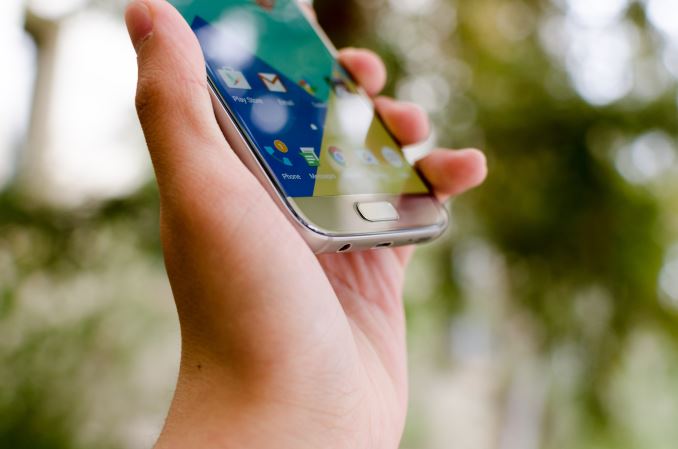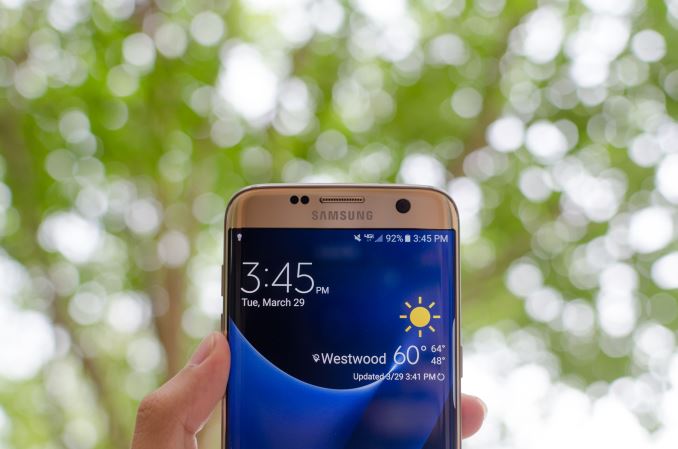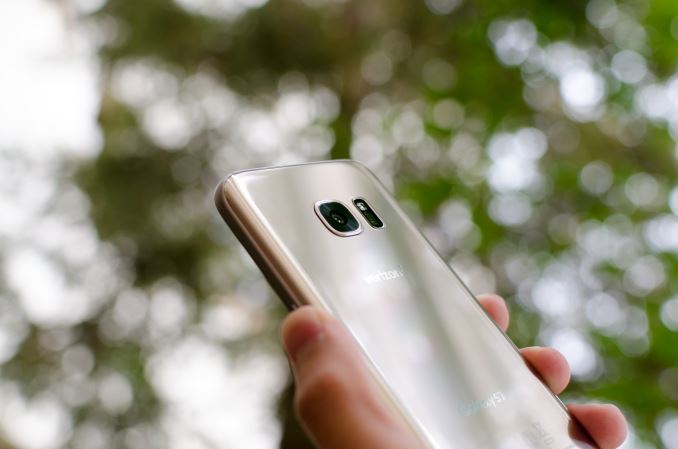The Samsung Galaxy S7 and S7 edge Review: Part 2
by Joshua Ho on July 5, 2016 8:00 AM ESTFinal Words
The Galaxy S7 in a lot of ways represents the sort of end game for the smartphone market, but before we get into these kinds of overarching discussions I want to recap everything we’ve learned about the Galaxy S7 before we get into the conclusion in earnest, which includes part 1 of this review.
We can start with design, where the Galaxy S7 shows quite a bit of resemblance to the Galaxy S6, with clear influence from the Galaxy Note5. Ergonomically the Galaxy S7 is just a step up. The Galaxy S7 edge is really more of the same as well, and I still have the same complaints about how the edge display affects ergonomics in a way that it doesn’t on the Galaxy S7, but both are okay. The one major note I have here since part 1 of the review is that screen protectors other than wet-applied TPU types are not really going to work properly on either the Galaxy S7 or S7 edge as the curve in the glass for both begins before the end of the display, so anything that is flat won’t cover the entire screen the way you might expect for the HTC 10 or iPhone 6s. The design doesn’t really blow me away, but it’s decent for its time.
The next notable area is battery life. While I’ve seen a lot of people rave about battery life on the Galaxy S7, however I don't feel the data backs this up. The Exynos 8890 variant is generally a step up in battery life, but the Snapdragon 820 variant is basically comparable to Exynos 7420 and by extension the Galaxy S6 and Note5. The Galaxy S7 edge is the only device that is an obvious step up in battery life for both variants, but this is through sheer battery capacity rather than any efficiency gains, as the Galaxy S7 edge ends up being a fairly heavy device in return for its great battery life. Charge time on both devices is competitive and in-line with expectations.
SoC performance, as well as storage performance are all commendable, but in general I don’t think there’s really been an appreciable change in the landscape with regard to SoCs. Snapdragon 820 and Exynos 8890 are both decently fast, but their speed is not really all that notable compared to Apple’s A9 SoC, especially when you consider things like browser performance which is heavily reliant on single-threaded performance. Kyro/Cortex-A72 is as good as you can get in the Android ecosystem at this time, so among Android phones this is top-tier performance, but in the broader landscape it's going to be overshadowed by what Apple has done.
The Galaxy S7 with Snapdragon 820 is also strangely slow in real-world situations as seen by Discomark, which is honestly somewhat puzzling. Samsung needs to put some real optimization effort into their Snapdragon devices as they actually trail the competition here to some extent, although if you aren’t that observant it’s unlikely you’ll notice a huge difference. Storage performance is great, but not really comparable to the iPhone 6s. This isn’t really a function of NVMe or UFS, but the design of the storage system itself. Given that Samsung is developing fairly small BGA SSDs already, I suspect the delta will go away soon. If you take away Apple devices, Samsung continues to ship some of the best storage on the market.
On the display side, Samsung continues to ship great AMOLED displays. While efficiency is not appreciably improved relative to the Galaxy S6 I would say that the best AMOLED panels now are greater than or equal to the best LCD panels. If Samsung can figure out how to reach efficiency parity with the best LCDs regardless of displayed content I would say that high end smartphones should really only be shipping AMOLED, but this is conditional upon whether OEMs can actually source these panels. Regardless, the Galaxy S7’s display is pretty much the best you can get in an Android device.
With camera, Samsung has managed to ship a fairly revolutionary camera sensor with phase detection at every pixel in the sensor, which makes it the fastest-focusing camera we’ve ever seen in a smartphone or tablet. Samsung has clearly prioritized speed here, and it’s great to see the kinds of amazing things Samsung is capable of achieving when their priorities are in the right place. However, with that said the output of the Galaxy S7 and S7 edge’s camera is not that impressive. I would argue that while it’s not worse than the iPhone 6s Plus, it is basically comparable. The real competition in this space comes from the HTC 10 and LG G5, the two of which manage to deliver arguably better still image output, and the HTC 10 manages to be comparable or better in video output other than slow motion. After a year of pointing out issues with slow motion video it seems Samsung has gotten around to shipping a solid implementation of this feature on the Galaxy S7, but they still seem to be limited by encode blocks on the Snapdragon 820 variant. The Galaxy S7 camera is good, but it’s not really amazing or all that well-rounded, unless you just don’t care about natural post-processing, good video stabilization, or detail-preserving noise reduction.
When it comes to WiFi, Samsung is doing an acceptable job, but not really a great one. The Broadcom BCM4359 chipset they’re shipping is a solid foundation, but throughput in general with respect to reception quality is just acceptable. Roaming latency is also well above what Apple is achieving with their devices. It does take enterprise-grade equipment to figure these issues out, but given the size of Samsung this should be a trivial task to get right. To be fair to Samsung, they are still doing better than HTC in this regard but Samsung is clearly trying to go after the enterprise market with the Galaxy S7 while HTC is still mostly targeting consumers.
The final area of discussion is software, and frankly Samsung’s UI just isn't something I find good. While the redesign with the Galaxy S5 was a solid step forward, in the time since Samsung has been stagnating in design yet again. While it’s fair to argue that design philosophies vary with culture, the Galaxy S7 is fundamentally an Android device and whatever changes Samsung makes to Android in terms of user interface need to be consistent in design so users have a similar experience with first party and third party apps. While themes can alleviate the issues to some extent, relying on third parties to solve fundamental problems with your user interface is really not what I would call a good user experience when themes can have noticeable effects on performance and battery life.
Outside of user interface design, it’s fairly obvious to me at this point that Samsung’s UI is just not particularly performant for whatever reason. While the 8890 variant might be better, the difference between the two SoCs is not so great that there should be noticeable frame drops in places like the app drawer, launcher, and settings app. Don’t get me wrong, the phone is usable despite these issues, but to continue justifying the $600+ USD price of these devices these problems just can’t be present.
Overall, the Galaxy S7 and S7 edge are solid phones, and overall are quite good. However looking at the broader path this phone has taken Samsung on, I’m left with the feeling that Samsung is just trying to follow industry trends rather than really approaching the design of their devices with some focus in mind. Samsung is clearly capable of incredible things as they were first to ship a device with UFS storage, the first to ship a 14nm FinFET SoC, and the first to ship a sensor with PDAF for each pixel.
The Galaxy S7 is clearly packed with features and ticks all the right boxes, but as soon as I start looking closer at everything I start to see cases where Samsung just doesn’t seem to care enough. Everything about the phone seems to be targeted towards being a great experience for the first week or two of ownership and while that strategy has worked well for them I’m left wondering what Samsung would be capable of if they cared about getting things right even if no one would notice the extra frame drop or 50ms of roam latency. I want Android phones that can be the best in the industry without any double standards, creative metrics, or qualifiers, and Samsung is clearly the OEM best-positioned to carry this out, so it's frustrating to see them fall short.
The Galaxy S7 and S7 edge are still great phones, but the difference between a $400 phone and a $700 phone are these details when phones like the OnePlus 3 are providing almost the same product at a dramatically reduced price. There are clear points of differentiation between the Galaxy S7 and OnePlus 3 or Mi5 in terms of features, but I don’t think it’s enough to be worth the $300. I think the only way to really justify the difference here is if you can get the Exynos 8890 version, which isn't necessarily an indictment of the Snapdragon 820, but rather the attention to detail that the Exynos variant receives.

















266 Comments
View All Comments
10basetom - Tuesday, July 5, 2016 - link
I would say the Exynos model is a little better than the SD820, but not significantly so.lilmoe - Tuesday, July 5, 2016 - link
No. It's a lot better. Almost generational. I went on a weekend trip with a friend who has a SD variant, the differences were too significant to the point he bought the Exynos variant....Even the camera processing is better. The Samsung sensor is even better than Sony's as well.
Ratman6161 - Tuesday, July 5, 2016 - link
As I read the article, I was sort of wondering at Samsung's rational for having two different versions. The Exynos seems to win a lot of the benchmarks and overall seems like the better SOC. I know I've been very happy with the 7420 in my Note 5.MonkeyPaw - Tuesday, July 5, 2016 - link
They may not be able to produce enough of them, so they dual source.adramaleck - Tuesday, July 5, 2016 - link
From my understanding the radio is part of the SOC on both chips. The US (Verizon and Sprint) is the only major market where CDMA is still in use. So in the rest of the world Samsung can sell one model which supports GSM frequencies and their own SOC. However, since Verizon (and I assume Sprint) require CDMA support in order for them to allow the phone on their network, Samsung probably find it more cost effective to use the Qualicom chip instead of adding support to the Exynos or producing their own.lilmoe - Wednesday, July 6, 2016 - link
What I was hoping for is a comprehensive deep dive of the differences in hardware of the GS7 series.The "true" GS7 models are equipped with Exynos SoCs and all-made-by Samsung parts (including camera sensor). The rest are mix and match units that are comparable to the rest of the "generic" premium flock of devices (including the G5 and HTC 10), in which share common components and only differ in design.
I seriously wouldn't have minded a review that craps all over Samsung for this deliberate variety in handset hardware, but instead we get a rather lazy attempt of a review where the author is trying really hard to be underwhelmed. Totally not worth the wait...
SunnyNW - Thursday, July 7, 2016 - link
This^. I visit the site quite often but have to agree "Totally not worth the wait..." I was under the impression that the delay might be to give us a detailed deep-dive into the different SOC architectures, you know the Kryo core and the new custom M1 from Samsung. Instead I am having a hard time understanding why it took so long to deliver this review, considering it as a whole...lolipopman - Tuesday, October 4, 2016 - link
Are you just going to disregard the GPU benchmarks? Or the fact that the throttling on Exynos is far more horrendous?Amazingly delusional.
zeeBomb - Saturday, July 9, 2016 - link
Holy crap. About time...rohanneo - Tuesday, July 5, 2016 - link
OH MY GOD!! I can't believe it. Been waiting for this article since months!!Really unprofessional of you guys to take TWO months for TWO parts of ONE REVIEW!! Be better next time.